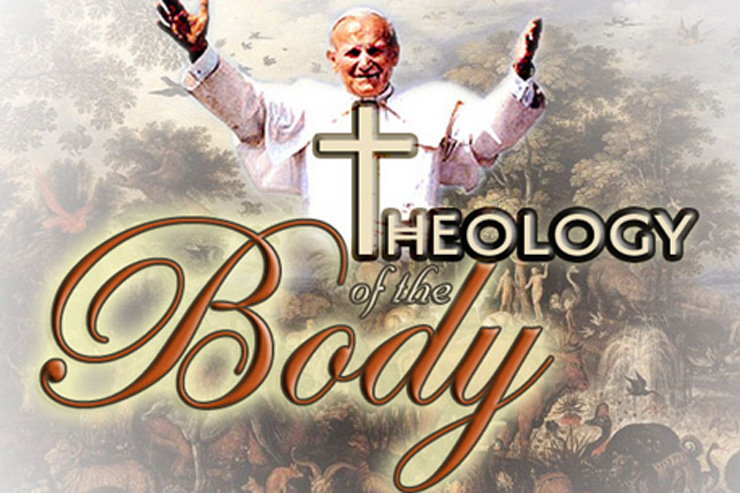Editor’s Note: This is the third in a series of articles written by Dr. Edward Sri on Saint John Paul II’s Love and Responsibility. The series is reprinted here with permission and originally appeared in the May/June 2005 issue of Lay Witness magazine. © 2005 Catholics United for the Faith / www.cuf.org/Laywitness/index.asp
A man eating lunch at a restaurant notices an attractive woman at another table, and is immediately drawn to her beauty. His heart stirs, and he finds himself wanting to see her again.
Yet, this is not the first time she has caught his eye. And his attraction to her is more than physical. She works for the same large company, and he has been drawn to her warm personality, her cheerful smile and her kindness toward others. He is taken in by her alluring personality as much as by her natural beauty.
Basic attractions like this happen all the time between men and women. Sometimes they are felt very quickly: A man standing in line at a store may immediately find himself attracted to a woman he sees walking by. A woman at church may notice a man praying after Mass and find herself wondering about him the rest of the day. Sometimes deeply felt attractions take a longer time to develop: A man and a woman who were friends or colleagues for several months may gradually find themselves attracted to one another emotionally and physically.
In his book Love and Responsibility, John Paul II analyzes the anatomy of an attraction. What is really happening when men and women find themselves attracted to one another?
The Anatomy of an Attraction
Let’s begin by explaining a few of the Pope’s terms. At the most basic level, to attract someone means to be regarded by that person as a good (p. 74). In turn, to be attracted to someone else means that I perceive some value in that person (such as their beauty, virtue, personality, etc.), and I respond to that value. This attraction involves the senses, the mind, the will, the emotions, and our desires.
The reason men and women are so easily attracted to each other is because of the sexual urge. Recall that the sexual urge is the tendency to seek the opposite sex. With the sexual urge, we are particularly oriented toward the physiological and psychological qualities of a person of the opposite sex-their body and their masculinity or femininity. John Paul II calls these physical and psychological qualities the “sexual values” of a person.
Therefore, a person is easily attracted to someone of the opposite sex in two ways: physically and emotionally. First, a man is attracted physically to the body of a woman, and a woman is attracted to the body of a man. The Pope calls this attraction to the body sensuality.
Second, a man is also attracted emotionally to the femininity of a woman, and the woman is emotionally attracted to the masculinity of a man. The Pope calls this emotional attraction sentimentality.
Sense and Sensuality
As we have seen, sensuality is concerned with the sexual value connected to the body of a person of the opposite sex. Such an attraction is not bad in itself because the sexual urge is meant to draw us not simply toward the body, but the body of a person. Hence, an initial sensual reaction is meant to orient us toward personal communion (not just bodily union), and can serve as an ingredient of authentic love if it is integrated with the higher, nobler aspects of love-such as good will, friendship, virtue, or self-giving commitment (p. 108).
Nevertheless, the Pope says that sensual attractions, on their own, can lead to great dangers. First, “sensuality by itself is not love and may very easily become its opposite” (p. 108). The reason sensuality can be so dangerous is that, on its own, it can easily fall into utilitarianism. When only sensuality is stirred, we experience the body of the other person as “a potential object of enjoyment.” We reduce the person to their physical qualities-their good looks, their body. And we view the person primarily in terms of the pleasure we can experience from those qualities.
What is most tragic here is that sensual desire, which is meant to orient us toward communion with the person of the opposite sex, can actually keep us from loving that person. A man, for example, may sensuously ponder in his mind or actively seek the body of a woman as a means for sexual gratification. And he may do this without any real interest in her as a person. He can focus on her sexual values-and the pleasure he derives from those values-to the point that his sensuous attraction to her body actually keeps him from responding to her value as a person. This is why the Pope says sensuality by itself is blinding to the person. “Sensuality in itself has a ‘consumer orientation’-it is directed primarily and immediately towards a ‘body’: it touches the person only indirectly, and tends to avoid direct contact” (p. 105).
Love Chocolate?
Second, the Pope says sensuality on its own not only misses the person, but even fails to grasp the true beauty of the body. He explains how beauty is experienced through contemplation, not the stirring desire to exploit. When contemplating the splendor of a landscape, a sunset, a piece of music or a work of art, one is taken in by the beauty. This contemplation of beauty brings peace and joy. This is very different from a “consumer attitude” to exploit an object for pleasure-an attitude which brings unrest, impatience, and an intense desire for satisfaction.
Perhaps an analogy will be helpful here. I once had the opportunity to see the work of a “chocolate artist.” The artist had on display dozens of elaborate sculptures of ships, flowers, birds, towers, and buildings. What made these large sculptures so impressive is that they were all made of black, brown, and white chocolate!
There are two different attitudes I could have toward these chocolate sculptures. On one hand, I could gaze upon them as works of art, admiring their beauty and allowing myself to be taken in by their immensity, their perfect proportions, the intricate details, and the workmanship, marveling that these delicate masterpieces were made out of sugar and cocoa.
On the other hand, I could ignore the fact that these sculptures are beautiful pieces of art to be contemplated, and view them primarily as candies to be devoured-good tasting chocolates that would satisfy my cravings! This latter approach, however, would be a degradation of the confectioner’s masterpieces, reducing them to mere objects to be exploited for my own pleasure.
Similarly, sensuality on its own fails to see the human body as a beautiful masterpiece of God’s creation, for it reduces the body to being an object to be exploited to satisfy one’s own sensuous cravings. “Thus, sensuality really interferes with the apprehension of the beautiful, even of bodily, sensual beauty, for it introduces a consumer attitude to the object: ‘the body’ is then regarded as a potential object of exploitation” (pp. 106-107).
Michelangelo and Playboy
This also helps explain one big difference between pornography and good classical art that depicts the nakedness of a person. Both Playboy magazine and some art in the Vatican Museum, for example, may present the sexual organs of the human body. In fact, some in the pornography industry say their pictures are just another form of art, portraying the beauty of the body. Some defenders of pornography have even asked why the Church condemns pornography but allows nakedness depicted in some of its own museums!
The pornography of Playboy, however, does not draw attention to the beauty of the human body. It draws attention to the body as an object to be used for one’s own sexual satisfaction. In the end, it is a reduction of the human person to the sexual value of the body. On the contrary, good art depicting the body as beautiful is not a reduction of the person, but an enlarging of the person, leading us to contemplate the mystery of the human person as a masterpiece in God’s creation.
Good art leads us to a peaceful contemplation of the true, the good, and the beautiful, including the truth, goodness, and beauty of the human body. Pornography, on the other hand, does not lead us to such contemplation, but rather stirs in us a sensuous craving for the body of another person as an object to be exploited for our own pleasure. Put simply: There probably aren’t many men who have fallen into sin by gazing upon Michelangelo’s famous portrayals of Adam and Eve in the Sistine Chapel. But there probably aren’t many men who have not fallen into lustful thoughts when looking at pictures in Playboy.[1]
Enslaved to Sensuality
A third reason John Paul II is concerned about sensuality is that, if it is left unchecked, we will become enslaved to everything that stimulates our sensual desire. For example, a man given in to sensuality finds his will so weakened that he is led around by whatever sexual values appear most immediately to his senses. Whenever he encounters a woman dressed a certain way, he cannot help but glance at her with impure thoughts. Whenever he sees images of women on TV, on the Internet, or on highway billboards, he cannot resist looking at them, as he hankers after the sexual value of the woman and wants to enjoy the pleasure he can derive from his glances.
Especially in a highly sexualized culture like ours, we are constantly bombarded with sexual images exploiting our sensuality, getting us to focus on the body of the opposite sex. Indeed, we can easily find ourselves enslaved, bouncing from one sexual value, to the next, to the next as they appear before our senses. As John Paul II points out, sensuality on its own “is characteristically fickle, turning wherever it finds that value, whenever a ‘possible object of enjoyment’ appears” (p. 108).
“I Can Look, But Can’t Touch”
Furthermore, in one of his most profound points in this section, the Pope warns that one can use a person’s body even when that person is not physically present. A man, for example, does not need to see, hear, or touch a woman to exploit her body for his own sensuous pleasure. Through his memory and imagination, he “can make contact even with the ‘body’ of a person not physically present, experiencing the value of that body to the extent that it constitutes a ‘possible object of enjoyment'” (pp. 108-9).
We live in a culture where many men say to themselves, “What’s wrong with having lustful thoughts about a woman? I’m not hurting anyone when I do that!” Even some married men may think, “I’m not committing adultery when I look at another woman this way. I’m still faithful to my wife. I can look; I just can’t touch.” However, we must remember Christ’s stern words about this matter: “Every one who looks at a woman lustfully has already committed adultery with her in his heart” (Mt. 5:28).
John Paul II’s insights help explain what is really happening when men look lustfully at women and why consenting to impure thoughts and sexual fantasies is always morally wrong and degrading to women. In the mind of a lustful man, the woman is reduced to the sexual value of her body. He treats her not as a person, but as a body to be exploited for his own pleasure in his glances and in his thoughts. And this can happen even when the woman is not around at all, for he can still make contact with her body to exploit her for his own sexual satisfaction in his memory and in his imagination. This is crass utilitarianism-a far cry from authentic love.
In summary, John Paul II emphasizes that sensuality alone is not love. It can be “raw material” for the development of true love. But this yearning for the sexual value of the body must be supplemented by other nobler elements of love, such as good will, friendship, virtue, total commitment, and self-giving love (themes to be discussed in subsequent articles). If sensuality is not carefully integrated with these higher elements of love, sensual desire will be harmful for a relationship. In fact, it can destroy love between a man and woman, and it can even prevent love from ever developing between a man and a woman.
Footnotes:
[1] The Pope specifically discusses this topic of art and pornography later in Love and Responsibility. First, he says art may at times portray the sexual aspect of man and woman and their love for each other. “Art has a right and a duty, for the sake of realism, to reproduce the human body, and the love of man and woman, as they are in reality, to speak the whole truth about them. The human body is an authentic part of the truth about man, just as its sensual and sexual aspects are an authentic part of the truth about human love” (p. 192). The Pope goes on to say, however, that it would be wrong to portray the sexual values in a way that overshadows the true value of the person. And it would be wrong to portray the sexual aspect of a couple’s relationship in a way that obscures their authentic love for each other, which is much more than sexual. This is the problem with pornography: It draws attention to the sexual aspect of a man or woman in a way that prevents us from seeing the true value of the person and the full truth of love. “Pornography is a marked tendency to accentuate the sexual element with the object of inducing the reader or viewer to believe that the sexual values are the only real values of the person, and that love is nothing more than the experience of those values alone. This tendency is harmful, for it destroys the integral image of that important fragment of human reality, which is love between man and woman. For the truth about human love consists always in reproducing the interpersonal relationship, however large sexual values may loom in that relationship. Just as the truth about man is that he is a person, however conspicuous sexual values are in his or her physical appearance” (pp. 192-3).
Acknowledgement
(This is the third in a series on Saint John Paul II’s Love and Responsibility)
 If you enjoyed this article from Edward Sri’s series on Saint John Paul II’s, Love and Responsibility, and want to learn more about theology of the body, see his book, Men, Women and the Mystery of Love: Practical Insights on John Paul II’s Love and Responsibility (Servant Books).
If you enjoyed this article from Edward Sri’s series on Saint John Paul II’s, Love and Responsibility, and want to learn more about theology of the body, see his book, Men, Women and the Mystery of Love: Practical Insights on John Paul II’s Love and Responsibility (Servant Books).
All references in this column to Saint John Paul II’s Love and Responsibility are taken from the 1993 edition, published by Ignatius Press.
Reprinted with permission from the May/June 2005 issue of Lay Witness magazine. © 2005 Catholics United for the Faith / www.cuf.org/Laywitness/index.asp














